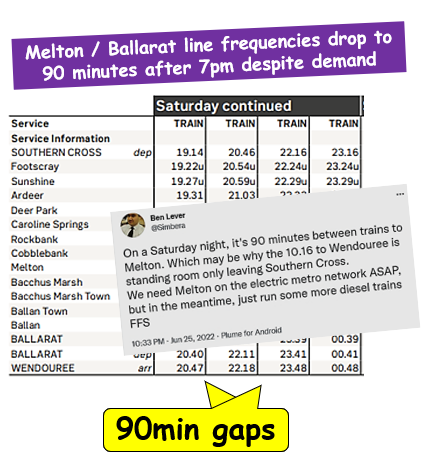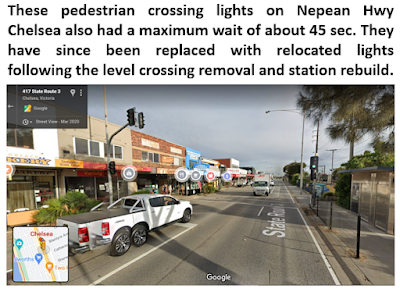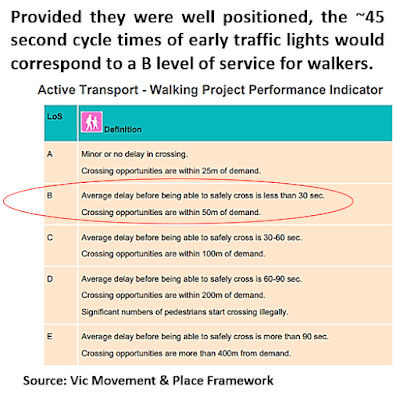How easily can you travel between Victoria's second, third and fourth largest cities exclusively by rail?
All have train stations in their CBD. And their lines intersect somewhere in metropolitan Melbourne. So the answer boils down to how good the connections between them are. That's what I'll try to answer today.
From Melbourne all three lines head west to Sunshine and then fan out. Bendigo branches north while Ballarat and Geelong separate just west of Deer Park. Hence Deer Park serves as an interchange point for Geelong - Ballarat travellers.
Footscray does the same for those travelling to Bendigo. This involves backtracking from Sunshine as, despite hopes about it being a transport 'superhub', Bendigo trains don't currently stop there.
Geelong - Ballarat
The earliest you can reach Ballarat from Geelong is just before 9am. Because both lines operate hourly at this time connections are a reasonable 19 minutes at Deer Park for the first two trips. Total travel time is 2hr 11 min.
From late morning the pattern changes as Geelong trains improve to every 40 minutes while Ballarat trains stay hourly. These unharmonised frequencies mean varying wait times. Typically either 19, 39 or 59 minutes. In other words a 1 in 3 chance of making a reasonable connection.
What does a 59 minute connection mean if the train you’re changing to comes hourly? It means that if you are arriving you will likely see the previous train departing. It’s a bad experience for passengers and should be avoided. It happens six times on Saturdays at Deer Park under current timetables. This puts the onus on passengers to carefully choose trips that connect rather than on the network to provide it as a matter of course. This reduces effective frequency, travel flexibility and thus network usefulness.
There’s fewer trips here as I’ve only shown Geelong trains that have a connection from the less frequent Ballarat service. Interchange times at Deer Park are mostly :04, :24 and :44. None are ideal with 4 minutes too tight for good reliability and :24 and :44 adding to journey time.
Ballarat - Bendigo
Unlike what we saw between Ballarat and Geelong, Ballarat and Bendigo trains operate at close to an hourly headway during the day. This means that connections are likely to be either consistently good or consistently bad.
The earliest a train – train trip will get you to Bendigo is 9:55am if starting at Ballarat. This is the second Bendigo train from Melbourne as there was a first, departing Southern Cross at 7:01am, arriving at 8:58am. The V/Line timetable shows an early coach leaving Ballarat at 5:35am. However this arrives Southern Cross at 7:05am, missing the Bendigo train by 4 minutes. This illustrates the effect of a few minutes in determining how early and late you can and cannot reach a place.
As for the rest of the day, waiting times at Footscray are typically 36 minutes out of a 3hr 37 minute trip. Why Footscray and not Sunshine, when both lines go through there? The answer is that Bendigo trains don’t stop at Sunshine.
If they did and timetables were optimised then Ballarat to Bendigo travel time could be cut by 20% to about 3 hours. Removing such backtracking and speeding overall travel times are the sort of ‘quick wins’ that should be the 'bread and butter' of Department of Transport and V/Line planning work. Where constraints exist to not currently permit this then this should drive investment and reform in areas like infrastructure and operating practices.
What happens at night? There are some quick trips (3hr 9 min) but these are based on tightish (7 min) connections. Maybe they’re not tight by Japanese and Swiss standards but we don’t have their reliability. It can sometimes be hard to make the business case for better reliability and even basic maintenance stack up on assessment criteria used. Flashy new station roofs are sometimes seen as having greater electoral appeal even while tracks under them rot. However I should point out that the 2022 Victorian state budget has a $248m allocation for 'V/Line efficiency and reliability'.
There is again a >2 hour gap between the second last and last inbound train from Ballarat like we discussed before. Those in Ballarat would be wise to catch the second last train if at all possible and forego any food or entertainment they might have had. Why? It’s because the last train reaches Footscray at 22:46. When did the desired train to Bendigo leave there? 22:45 – 1 minute earlier. The result is an unsatisfactory 77 minute wait at Footscray for the next and last train at three past midnight.
To summarise, unless you are lucky taking a train from Bendigo to Ballarat on a Saturday (or likely Sunday) is a mugs’ game and you wouldn’t want to do it unless a stopover in Footscray was part of the plan.
Bendigo - Ballarat
Travel is happier for those going to Ballarat, provided there are no disruptions. Waiting time is 8 minutes for much of the day. Good if everything is running to time, but if not ...
The earliest you can reach Ballarat by train is 9:43am – a little earlier than going the other way. Again there’s an earlier train but the first train from Bendigo reaches Footscray 13 minutes too late to meet it. The subsequent and one other connection involves 47 – 49 minutes at Footscray until the pattern (mostly) settles down. Nothing operates at a suitable time to meet the train that arrives at 11:43am.
Evenings present 32 to 58 minute connections. The latter is because the last train (Footscray at 23:26) is two minutes after the Ballarat train at 23:24. However night owls have a coach option where they can go in to Southern Cross with a 15 minute change there. Total time is however still slower than earlier train trips.
Geelong - Bendigo
Here we're back to unharmonised frequencies and thus varying connection times at Footscray. Mostly they're about 26, 46 and around 60 minutes. The last happens if you choose an unsuitable train at Geelong; if you delay your departure to get the next train in 40 min time then you cut your waiting by that amount and end up on the same train to Bendigo. There are some reasonable 17 minute connections in the evening and a tight 6 minute connection in the afternoon.
Bendigo - Geelong
Like with Geelong - Bendigo you can get there by 9am on the first trip. Waits can be up to 39 minutes in the morning but settle down to an alternating 4 minute and 24 minute connection time in the afternoon. A problem arises at 17:58 where a train from Bendigo arrives at Footscray at exactly the same time as a Geelong train departs. This results in an impossible connection unless the Geelong train is serendipitously delayed.
Some evening connections are more consistent, though the 7 minutes for the last trip would be tight for the conservative traveller. Again Bendigo's 90 minute evening headways limit journey time flexibility. Like Ballarat and unlike Geelong (which has later trips) the last inbound service leaves at about 21:30.
Coach services operate from Geelong to Ballarat and Bendigo. The Geelong - Ballarat coach trip takes about 1 hr 35 min while Ballarat - Bendigo is about 2hr 15 min. Both these are faster than all-train trips. However trains, though less direct and involving a transfer, win out on frequency, particularly on weekends. With a coach travel speed 4hr 30 min (including a 40 min break at Ballarat), trains are always faster for Geelong - Bendigo travel.
Findings and solutions
Trying to travel between our largest regional cities in Victoria by train requires significant planning on the part of the passenger to avoid long waits or exposure to fragile connections with a high chance of failure. While trains on these lines are typically every 40 or 60 minutes at most times, the period between instances of good connections can be longer due to incompatible frequencies. For Ballarat to Bendigo frequencies may be harmonised but poor connections can repeat over most of the day.
Amongst the most cost-effective way to speed regional train travel and make the rail network less 'Melbourne-centric' would be to review timetables to optimise connections for inter-regional trips. This is likely to assume increasing importance given the regional-based nature of the 2026 Commonwealth Games.
As Melbourne outer areas grow, shorter trips like Tarneit to Melton are likely to grow in importance. These lack direct buses between them. For them V/Line is their local train service. Thus what's been written here about connectivity between regional cities applies in equal force to them, with travel time comparisons even less favourable compared to driving.
Need for higher frequency
Even ignoring connectivity concerns, higher frequency is needed to accommodate crowding. Adding carriages (where available) may be cheaper but, while it improves comfort, does not reduce waiting time or end-to-end travel speed like boosting frequency would. The most urgent need for improved frequency is at night where services frequencies drop to 90 - 120 minutes on the Ballarat and Bendigo lines. Inserting one or two extra trips to improve this to 40 - 60 minutes would make a substantial difference, especially if the day timetable pattern can be extended consistently into the night.
A VictoriaTakt?
A network planning approach that explicitly considers and promotes to the public connectivity between lines is essential. The idea is to harmonise frequencies and optimise connections at key interchange points, which in this context means Deer Park and Footscray (or Sunshine).
Because rail planners have done the painstaking planning and scheduling the passenger often does not need to. Thus they can hop on any train and expect good, reliable and repeating connections to important destinations.
The Swiss and German approach to achieving this is "First the timetable, then the infrastructure".
This is based on a vision of state (or country) wide mobility based on good connectivity across the network. This requires significant work in scheduling. Where this isn't efficient (eg a train's run time is too long for it to reach an interchange point in time) then consideration of infrastructure that would allow improved timing is given.
Options could include continuing to run some Geelong trains via Wyndham Vale, Sunshine and Footscray. That gives extra choice but there's the risk of splitting frequency (and lengthening some waits) unless service is vastly improved over now. Ideas for restoring direct rail service between Geelong, Ballarat and even Bendigo also bob up with local advocates including the Rail Revival Alliance. Hopes were raised by the Coalition parties before the 2010 state election (which they won) but their feasibility study found it would cost $935 million and not be viable.
Conclusion
We’ve identified three main problems with regional train timetables. Low frequencies at important travel times, unharmonised timetables and planning that doesn’t necessarily consistently optimise regional to regional trips.
Money invested in service, work done planning timetables and infrastructure priorities driven by network connectivity have big payoffs in saved time for passengers and likely higher patronage as more trips are made consistently easier.









































